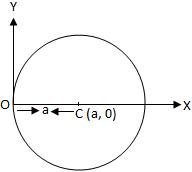Subscribe to our ▶️ YouTube channel 🔴 for the latest videos, updates, and tips.
Circle Passes through the Origin and Centre Lies on x-axis
We will learn how to find the equation of a circle passes through the origin and centre lies on x-axis.
The equation of a circle with centre at (h, k) and radius equal to a, is (x - h)\(^{2}\) + (y - k)\(^{2}\) = a\(^{2}\).
When the circle passes through the origin and centre lies on x-axis i.e., h = a and k = 0.
Then the equation (x - h)\(^{2}\) + (y - k)\(^{2}\) = a\(^{2}\) becomes (x - a)\(^{2}\) + y\(^{2}\) = a\(^{2}\)
If a circle passes through the origin and centre lies on x-axis then the abscissa will be equal to the radius of the circle and the y co-ordinate of the centre will be zero. Hence, the equation of the circle will be of the form:
(x - a)\(^{2}\) + y\(^{2}\) = a\(^{2}\)
⇒ x\(^{2}\) + y\(^{2}\) - 2ax = 0
Solved example on
the central form of the equation of a circle passes through the origin and
centre lies on x-axis:
1. Find the equation of a circle passes through the origin and centre lies on y-axis at (0, -2).
Solution:
Centre of the lies on y-axis at (0, -2)
Since, circle passes through the origin and centre lies on x-axis then the abscissa will be equal to the radius of the circle and the y co-ordinate of the centre will be zero.
The required equation of the circle passes through the origin and centre lies on y-axis at (0, 2) is
(x + 7)\(^{2}\) + y\(^{2}\) = (-7)\(^{2}\)
⇒ x\(^{2}\) + 14x + 49 + y\(^{2}\) = 49
⇒ x\(^{2}\) + y\(^{2}\) + 14x = 0
2. Find the equation of a circle passes through the origin and centre lies on x-axis at (12, 0).
Solution:
Centre of the lies on x-axis at (12, 0)
Since, circle passes through the origin and centre lies on x-axis then the abscissa will be equal to the radius of the circle and the y co-ordinate of the centre will be zero.
The required equation of the circle passes through the origin and centre lies on x-axis at (12, 0) is
(x - 12)\(^{2}\) + y\(^{2}\) = 12\(^{2}\)
⇒ x\(^{2}\) - 24x + 144 + y\(^{2}\) = 144
⇒ x\(^{2}\) + y\(^{2}\) - 24x = 0
● The Circle
- Definition of Circle
- Equation of a Circle
- General Form of the Equation of a Circle
- General Equation of Second Degree Represents a Circle
- Centre of the Circle Coincides with the Origin
- Circle Passes through the Origin
- Circle Touches x-axis
- Circle Touches y-axis
- Circle Touches both x-axis and y-axis
- Centre of the Circle on x-axis
- Centre of the Circle on y-axis
- Circle Passes through the Origin and Centre Lies on x-axis
- Circle Passes through the Origin and Centre Lies on y-axis
- Equation of a Circle when Line Segment Joining Two Given Points is a Diameter
- Equations of Concentric Circles
- Circle Passing Through Three Given Points
- Circle Through the Intersection of Two Circles
- Equation of the Common Chord of Two Circles
- Position of a Point with Respect to a Circle
- Intercepts on the Axes made by a Circle
- Circle Formulae
- Problems on Circle
11 and 12 Grade Math
From Circle Passes through the Origin and Centre Lies on x-axis to HOME PAGE
Didn't find what you were looking for? Or want to know more information about Math Only Math. Use this Google Search to find what you need.



New! Comments
Have your say about what you just read! Leave me a comment in the box below. Ask a Question or Answer a Question.